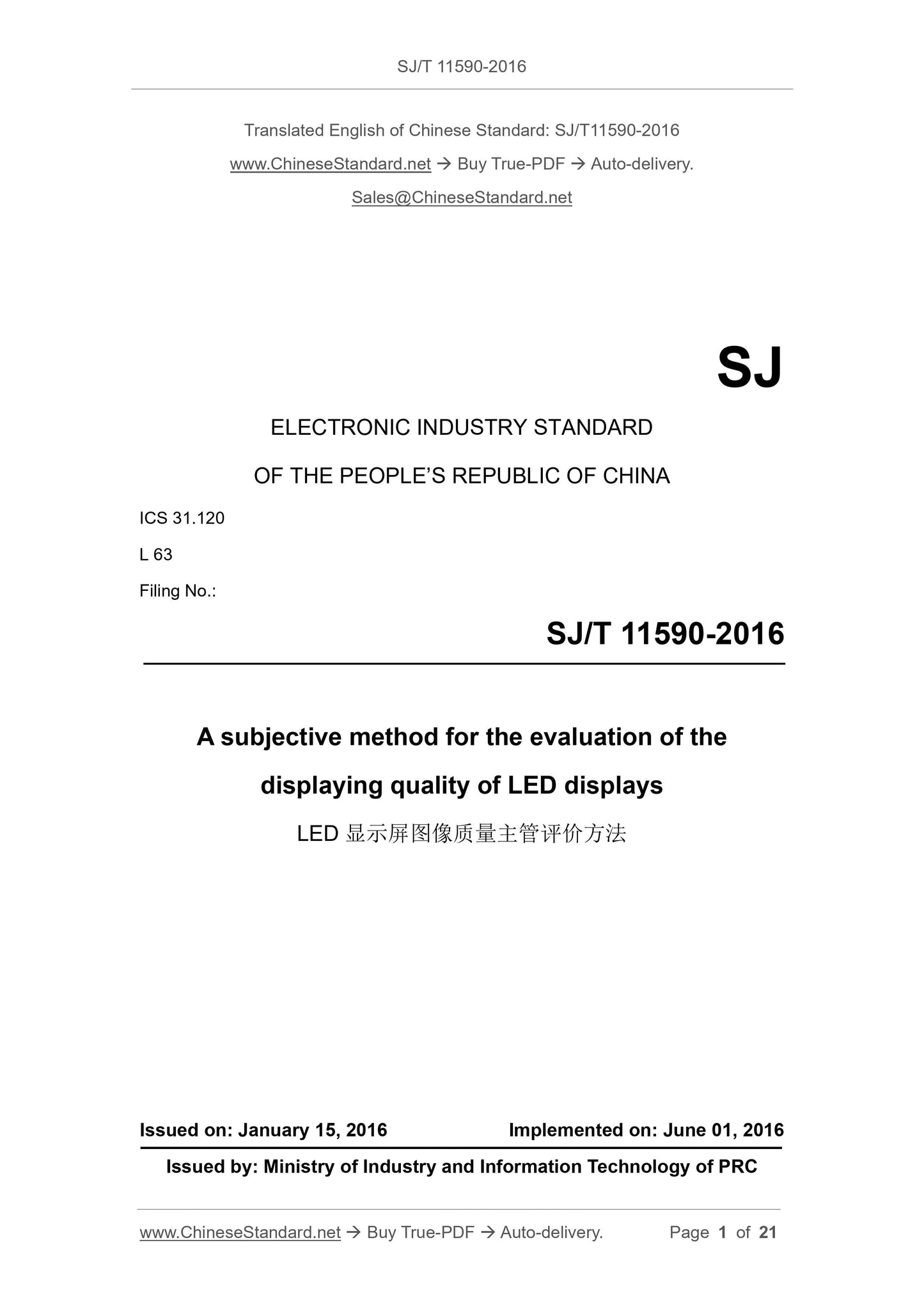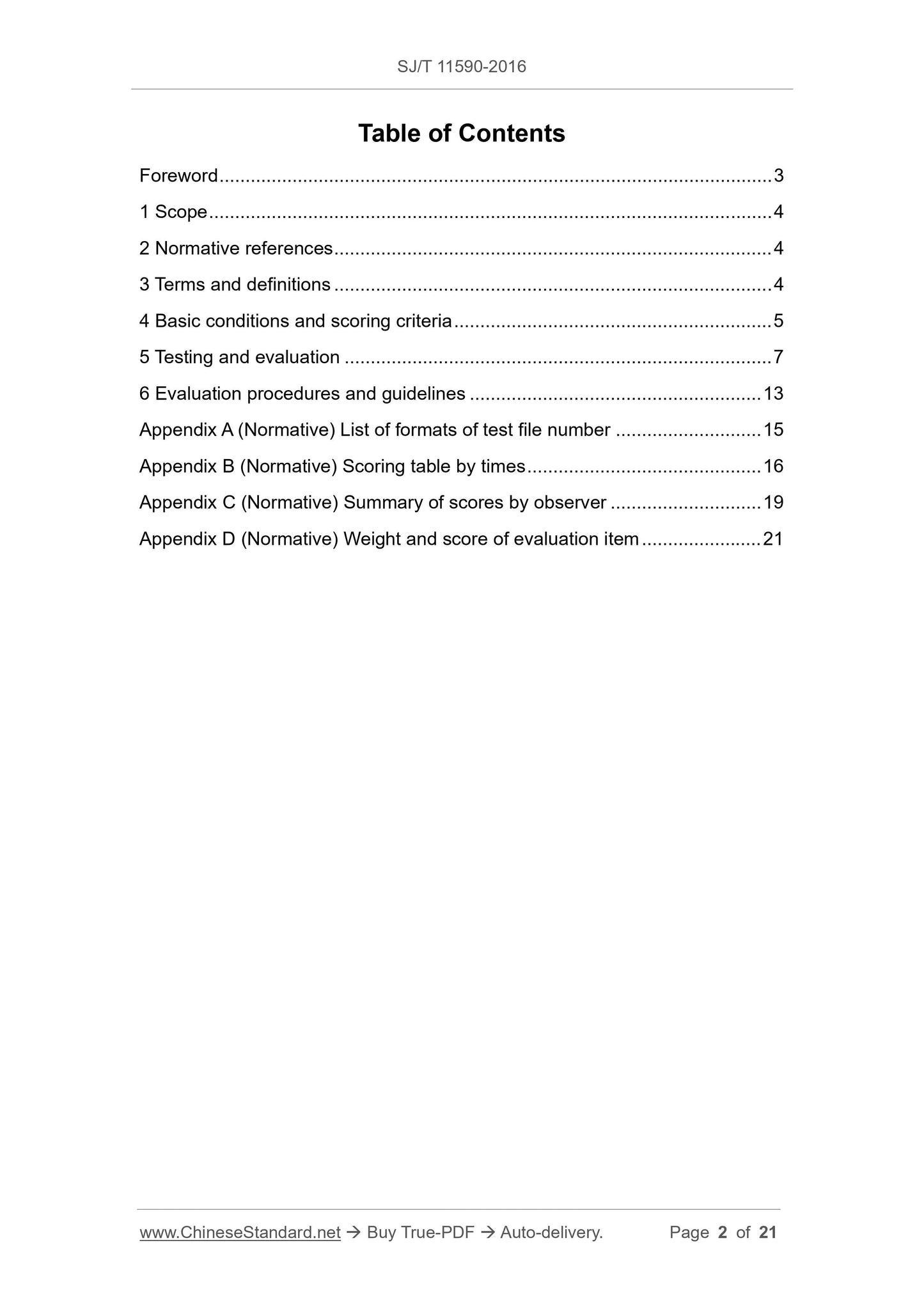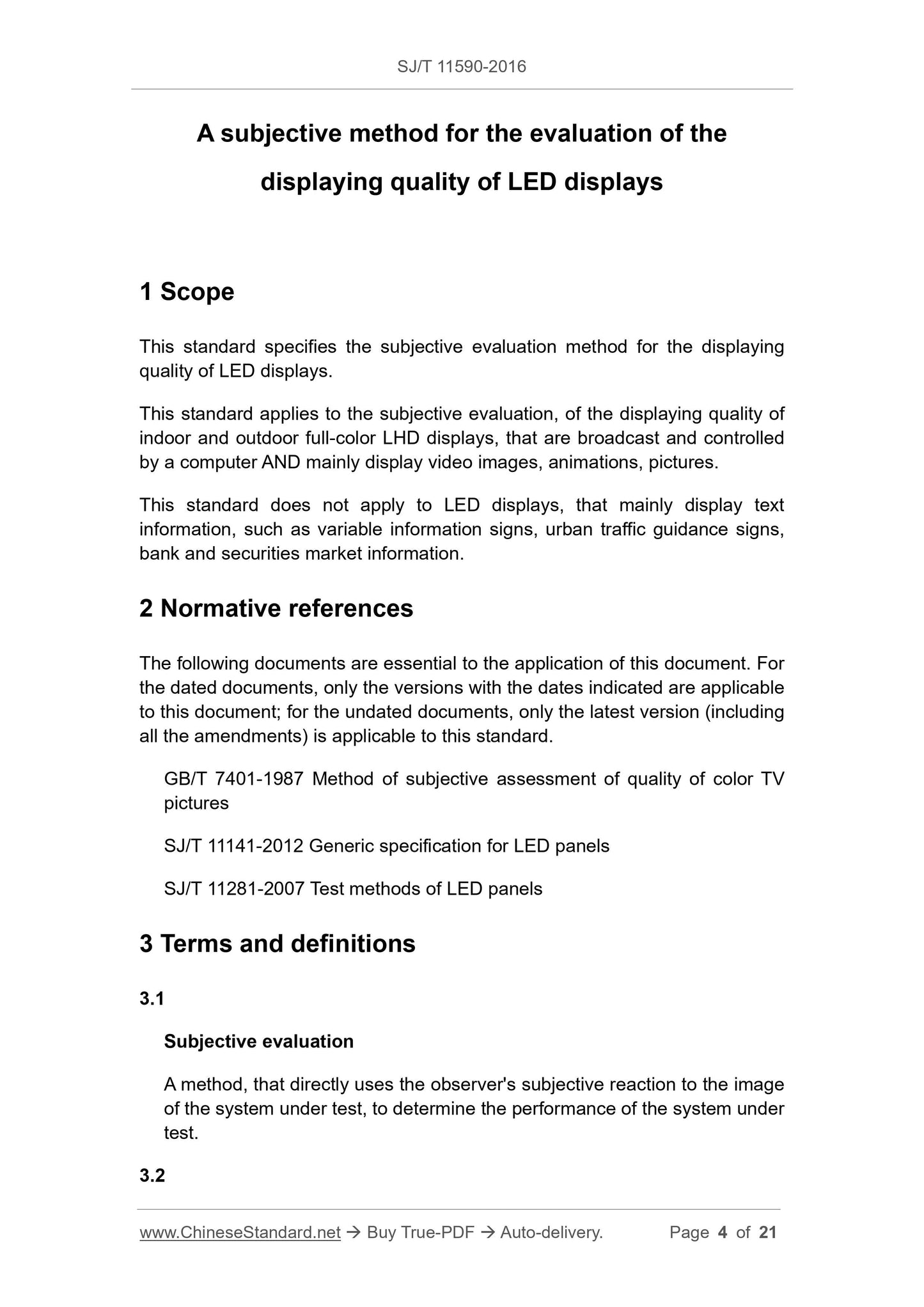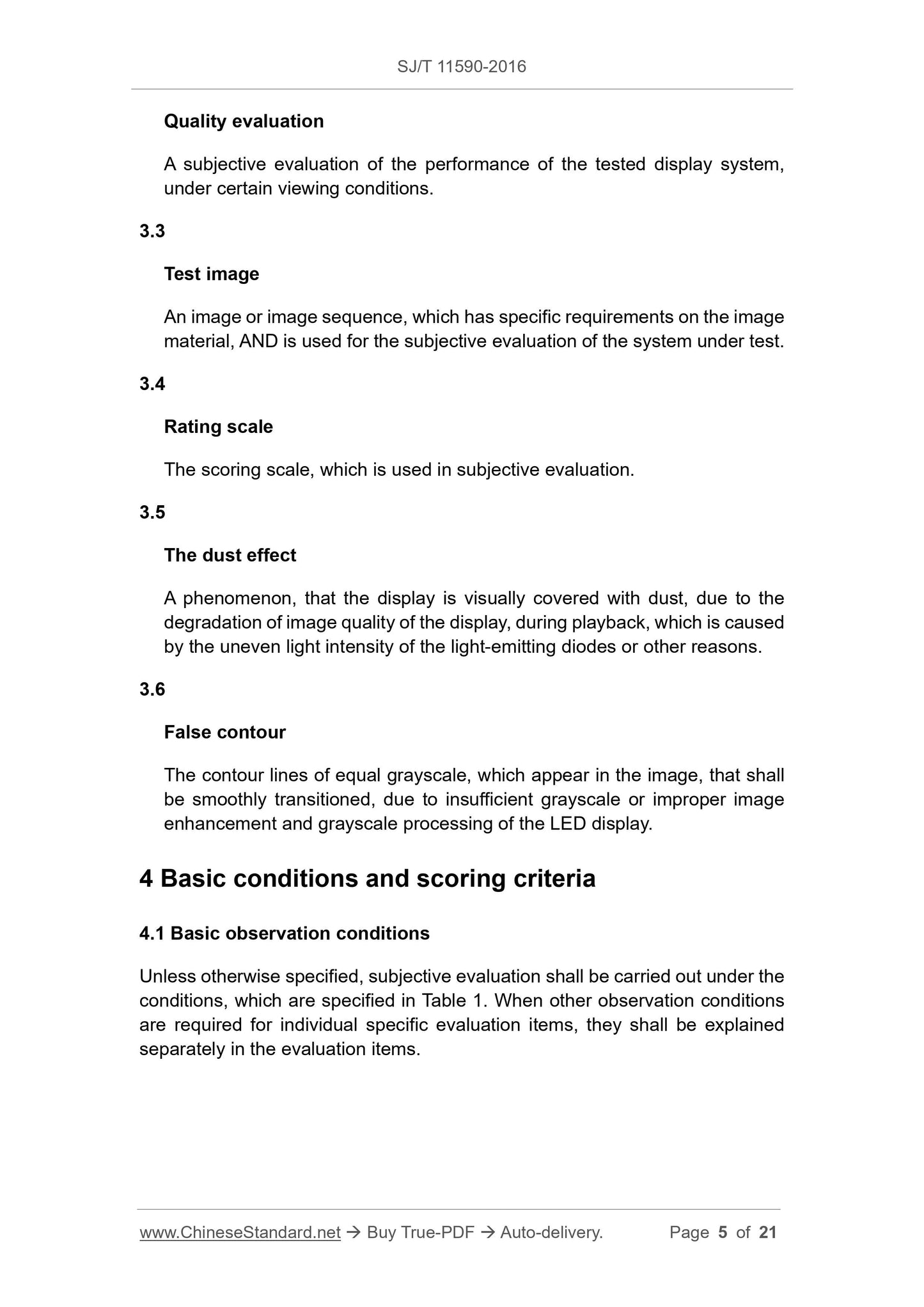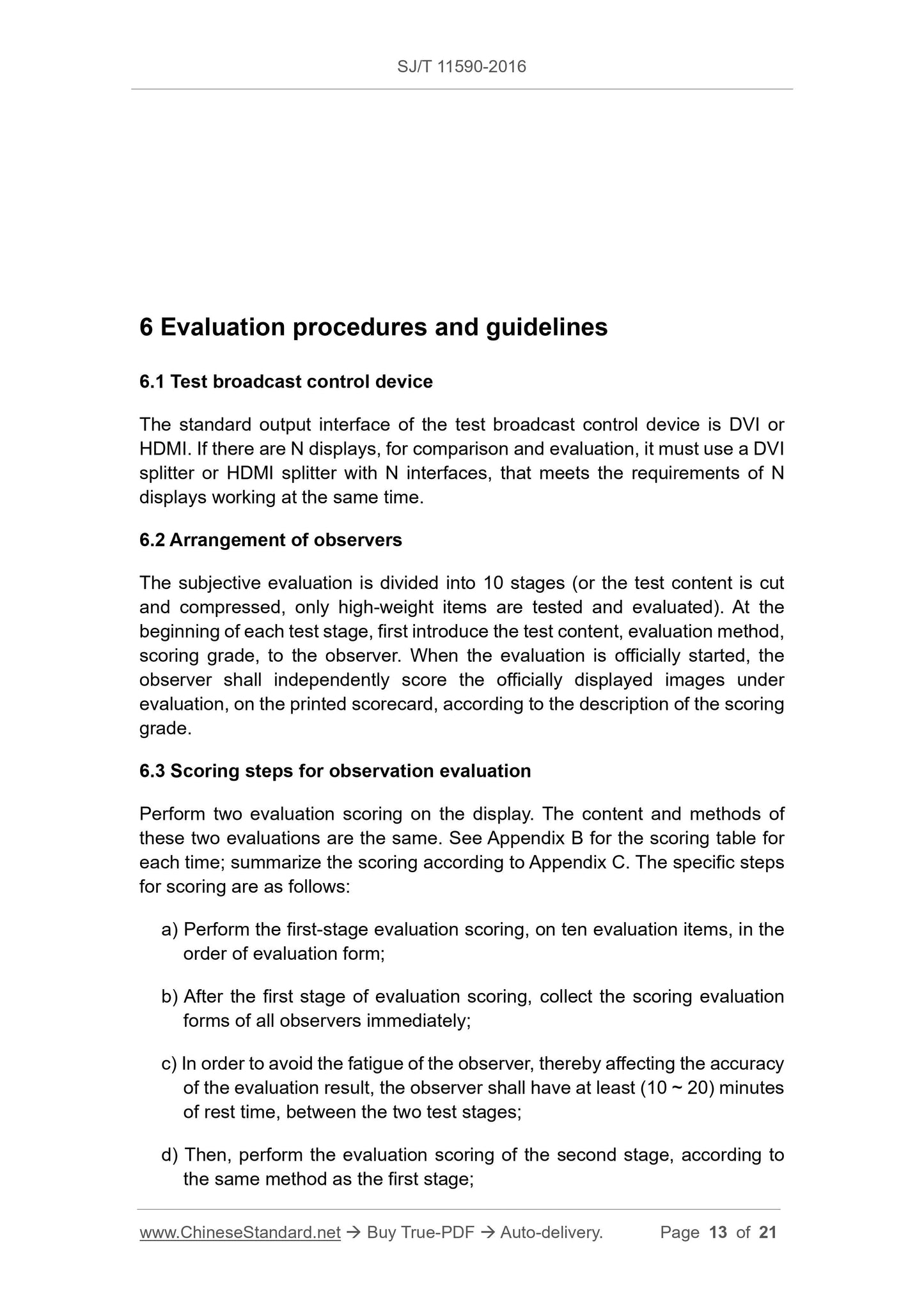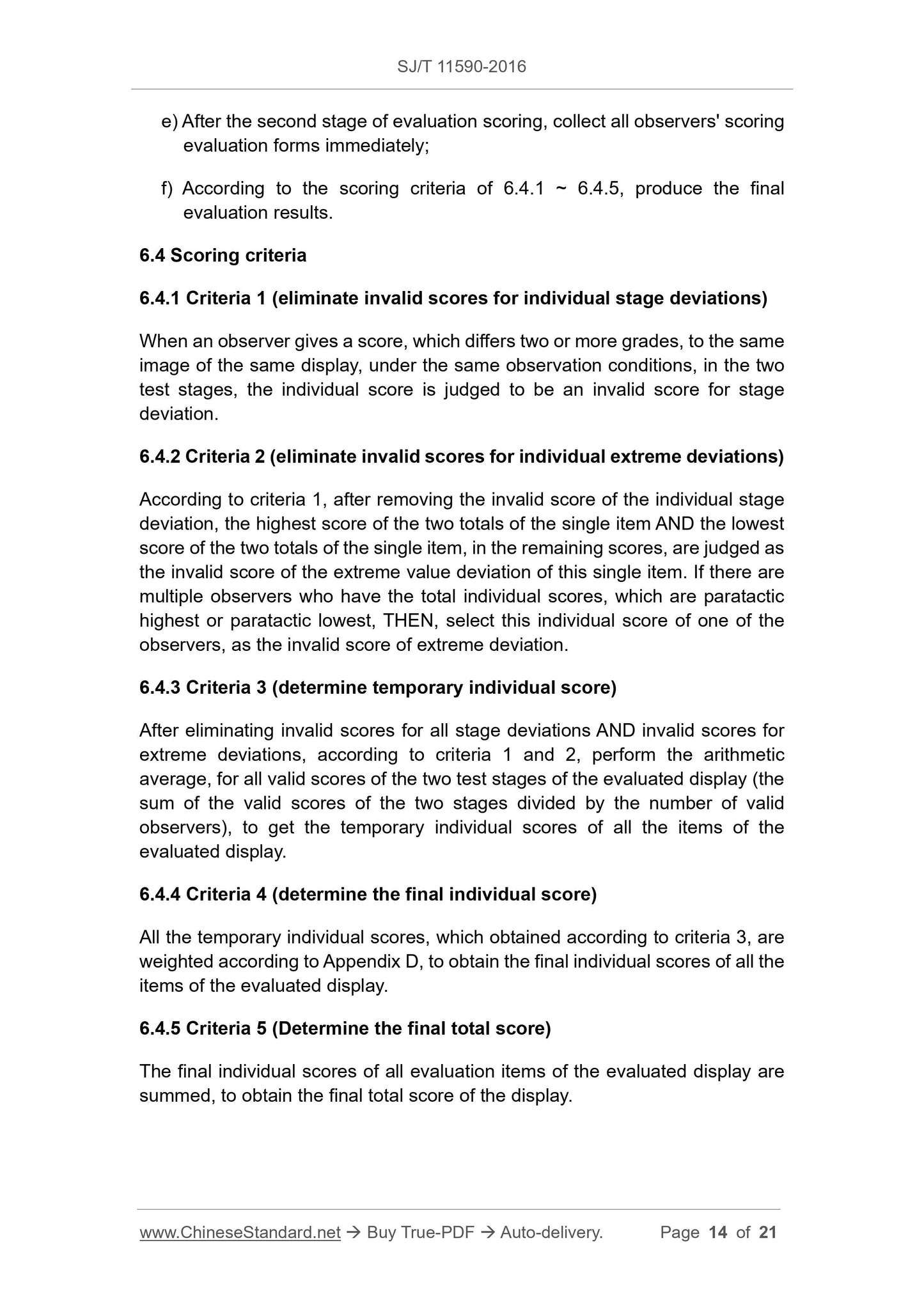1
/
of
6
PayPal, credit cards. Download editable-PDF & invoice in 1 second!
SJ/T 11590-2016 English PDF (SJT11590-2016)
SJ/T 11590-2016 English PDF (SJT11590-2016)
Regular price
$425.00 USD
Regular price
Sale price
$425.00 USD
Unit price
/
per
Shipping calculated at checkout.
Couldn't load pickup availability
Delivery: 3 seconds. Download true-PDF + Invoice.
Get QUOTATION in 1-minute: Click SJ/T 11590-2016
Historical versions: SJ/T 11590-2016
Preview True-PDF (Reload/Scroll if blank)
SJ/T 11590-2016: A subjective method for the evaluation of the displaying quality of LED displays
SJ/T 11590-2016
SJ
ELECTRONIC INDUSTRY STANDARD
OF THE PEOPLE’S REPUBLIC OF CHINA
ICS 31.120
L 63
Filing No.:
A subjective method for the evaluation of the
displaying quality of LED displays
ISSUED ON: JANUARY 15, 2016
IMPLEMENTED ON: JUNE 01, 2016
Issued by: Ministry of Industry and Information Technology of PRC
Table of Contents
Foreword ... 3
1 Scope ... 4
2 Normative references ... 4
3 Terms and definitions ... 4
4 Basic conditions and scoring criteria ... 5
5 Testing and evaluation ... 7
6 Evaluation procedures and guidelines ... 13
Appendix A (Normative) List of formats of test file number ... 15
Appendix B (Normative) Scoring table by times ... 16
Appendix C (Normative) Summary of scores by observer ... 19
Appendix D (Normative) Weight and score of evaluation item ... 21
A subjective method for the evaluation of the
displaying quality of LED displays
1 Scope
This standard specifies the subjective evaluation method for the displaying
quality of LED displays.
This standard applies to the subjective evaluation, of the displaying quality of
indoor and outdoor full-color LHD displays, that are broadcast and controlled
by a computer AND mainly display video images, animations, pictures.
This standard does not apply to LED displays, that mainly display text
information, such as variable information signs, urban traffic guidance signs,
bank and securities market information.
2 Normative references
The following documents are essential to the application of this document. For
the dated documents, only the versions with the dates indicated are applicable
to this document; for the undated documents, only the latest version (including
all the amendments) is applicable to this standard.
GB/T 7401-1987 Method of subjective assessment of quality of color TV
pictures
SJ/T 11141-2012 Generic specification for LED panels
SJ/T 11281-2007 Test methods of LED panels
3 Terms and definitions
3.1
Subjective evaluation
A method, that directly uses the observer's subjective reaction to the image
of the system under test, to determine the performance of the system under
test.
3.2
Quality evaluation
A subjective evaluation of the performance of the tested display system,
under certain viewing conditions.
3.3
Test image
An image or image sequence, which has specific requirements on the image
material, AND is used for the subjective evaluation of the system under test.
3.4
Rating scale
The scoring scale, which is used in subjective evaluation.
3.5
The dust effect
A phenomenon, that the display is visually covered with dust, due to the
degradation of image quality of the display, during playback, which is caused
by the uneven light intensity of the light-emitting diodes or other reasons.
3.6
False contour
The contour lines of equal grayscale, which appear in the image, that shall
be smoothly transitioned, due to insufficient grayscale or improper image
enhancement and grayscale processing of the LED display.
4 Basic conditions and scoring criteria
4.1 Basic observation conditions
Unless otherwise specified, subjective evaluation shall be carried out under the
conditions, which are specified in Table 1. When other observation conditions
are required for individual specific evaluation items, they shall be explained
separately in the evaluation items.
6 Evaluation procedures and guidelines
6.1 Test broadcast control device
The standard output interface of the test broadcast control device is DVI or
HDMI. If there are N displays, for comparison and evaluation, it must use a DVI
splitter or HDMI splitter with N interfaces, that meets the requirements of N
displays working at the same time.
6.2 Arrangement of observers
The subjective evaluation is divided into 10 stages (or the test content is cut
and compressed, only high-weight items are tested and evaluated). At the
beginning of each test stage, first introduce the test content, evaluation method,
scoring grade, to the observer. When the evaluation is officially started, the
observer shall independently score the officially displayed images under
evaluation, on the printed scorecard, according to the description of the scoring
grade.
6.3 Scoring steps for observation evaluation
Perform two evaluation scoring on the display. The content and methods of
these two evaluations are the same. See Appendix B for the scoring table for
each time; summarize the scoring according to Appendix C. The specific steps
for scoring are as follows:
a) Perform the first-stage evaluation scoring, on ten evaluation items, in the
order of evaluation form;
b) After the first stage of evaluation scoring, collect the scoring evaluation
forms of all observers immediately;
c) In order to avoid the fatigue of the observer, thereby affecting the accuracy
of the evaluation result, the observer shall have at least (10 ~ 20) minutes
of rest time, between the two test stages;
d) Then, perform the evaluation scoring of the second stage, according to
the same method as the first stage;
e) After the second stage of evaluation scoring, collect all observers' scoring
evaluation forms immediately;
f) According to the scoring criteria of 6.4.1 ~ 6.4.5, produce the final
evaluation results.
6.4 Scoring criteria
6.4.1 Criteria 1 (eliminate invalid scores for individual stage deviations)
When an observer gives a score, which differs two or more grades, to the same
image of the same display, under the same observation conditions, in the two
test stages, the individual score is judged to be an invalid score for stage
deviation.
6.4.2 Criteria 2 (eliminate invalid scores for individual extreme deviations)
According to criteria 1, after removing the invalid score of the individual stage
deviation, the highest score of the two totals of the single item AND the lowest
score of the two totals of the single item, in the remaining scores, are judged as
the invalid score of the extreme value deviation of this single item. If there are
multiple observers who have the total individual scores, which are paratactic
highest or paratactic lowest, THEN, select this individual score of one of the
observers, as the invalid score of extreme deviation.
6.4.3 Criteria 3 (determine temporary individual score)
After eliminating invalid scores for all stage deviations AND invalid scores for
extreme deviations, according to criteria 1 and 2, perform the arithmetic
average, for all valid scores of the two test stages of the evaluated display (the
sum of the valid scores of the two stages divided by the number of valid
observers), to get the temporary individual scores of all the items of the
evaluated display.
6.4.4 Criteria 4 (determine the final individual score)
All the temporary individual scores, which obtained according to criteria 3, are
weighted according to Appendix D, to obtain the final individual scores of all the
items of the evaluated display.
6.4.5 Criteria 5 (Determine the final total score)
The final individual scores of all evaluation items of the evaluated display are
summed, to obtain the final total score of the display.
Get QUOTATION in 1-minute: Click SJ/T 11590-2016
Historical versions: SJ/T 11590-2016
Preview True-PDF (Reload/Scroll if blank)
SJ/T 11590-2016: A subjective method for the evaluation of the displaying quality of LED displays
SJ/T 11590-2016
SJ
ELECTRONIC INDUSTRY STANDARD
OF THE PEOPLE’S REPUBLIC OF CHINA
ICS 31.120
L 63
Filing No.:
A subjective method for the evaluation of the
displaying quality of LED displays
ISSUED ON: JANUARY 15, 2016
IMPLEMENTED ON: JUNE 01, 2016
Issued by: Ministry of Industry and Information Technology of PRC
Table of Contents
Foreword ... 3
1 Scope ... 4
2 Normative references ... 4
3 Terms and definitions ... 4
4 Basic conditions and scoring criteria ... 5
5 Testing and evaluation ... 7
6 Evaluation procedures and guidelines ... 13
Appendix A (Normative) List of formats of test file number ... 15
Appendix B (Normative) Scoring table by times ... 16
Appendix C (Normative) Summary of scores by observer ... 19
Appendix D (Normative) Weight and score of evaluation item ... 21
A subjective method for the evaluation of the
displaying quality of LED displays
1 Scope
This standard specifies the subjective evaluation method for the displaying
quality of LED displays.
This standard applies to the subjective evaluation, of the displaying quality of
indoor and outdoor full-color LHD displays, that are broadcast and controlled
by a computer AND mainly display video images, animations, pictures.
This standard does not apply to LED displays, that mainly display text
information, such as variable information signs, urban traffic guidance signs,
bank and securities market information.
2 Normative references
The following documents are essential to the application of this document. For
the dated documents, only the versions with the dates indicated are applicable
to this document; for the undated documents, only the latest version (including
all the amendments) is applicable to this standard.
GB/T 7401-1987 Method of subjective assessment of quality of color TV
pictures
SJ/T 11141-2012 Generic specification for LED panels
SJ/T 11281-2007 Test methods of LED panels
3 Terms and definitions
3.1
Subjective evaluation
A method, that directly uses the observer's subjective reaction to the image
of the system under test, to determine the performance of the system under
test.
3.2
Quality evaluation
A subjective evaluation of the performance of the tested display system,
under certain viewing conditions.
3.3
Test image
An image or image sequence, which has specific requirements on the image
material, AND is used for the subjective evaluation of the system under test.
3.4
Rating scale
The scoring scale, which is used in subjective evaluation.
3.5
The dust effect
A phenomenon, that the display is visually covered with dust, due to the
degradation of image quality of the display, during playback, which is caused
by the uneven light intensity of the light-emitting diodes or other reasons.
3.6
False contour
The contour lines of equal grayscale, which appear in the image, that shall
be smoothly transitioned, due to insufficient grayscale or improper image
enhancement and grayscale processing of the LED display.
4 Basic conditions and scoring criteria
4.1 Basic observation conditions
Unless otherwise specified, subjective evaluation shall be carried out under the
conditions, which are specified in Table 1. When other observation conditions
are required for individual specific evaluation items, they shall be explained
separately in the evaluation items.
6 Evaluation procedures and guidelines
6.1 Test broadcast control device
The standard output interface of the test broadcast control device is DVI or
HDMI. If there are N displays, for comparison and evaluation, it must use a DVI
splitter or HDMI splitter with N interfaces, that meets the requirements of N
displays working at the same time.
6.2 Arrangement of observers
The subjective evaluation is divided into 10 stages (or the test content is cut
and compressed, only high-weight items are tested and evaluated). At the
beginning of each test stage, first introduce the test content, evaluation method,
scoring grade, to the observer. When the evaluation is officially started, the
observer shall independently score the officially displayed images under
evaluation, on the printed scorecard, according to the description of the scoring
grade.
6.3 Scoring steps for observation evaluation
Perform two evaluation scoring on the display. The content and methods of
these two evaluations are the same. See Appendix B for the scoring table for
each time; summarize the scoring according to Appendix C. The specific steps
for scoring are as follows:
a) Perform the first-stage evaluation scoring, on ten evaluation items, in the
order of evaluation form;
b) After the first stage of evaluation scoring, collect the scoring evaluation
forms of all observers immediately;
c) In order to avoid the fatigue of the observer, thereby affecting the accuracy
of the evaluation result, the observer shall have at least (10 ~ 20) minutes
of rest time, between the two test stages;
d) Then, perform the evaluation scoring of the second stage, according to
the same method as the first stage;
e) After the second stage of evaluation scoring, collect all observers' scoring
evaluation forms immediately;
f) According to the scoring criteria of 6.4.1 ~ 6.4.5, produce the final
evaluation results.
6.4 Scoring criteria
6.4.1 Criteria 1 (eliminate invalid scores for individual stage deviations)
When an observer gives a score, which differs two or more grades, to the same
image of the same display, under the same observation conditions, in the two
test stages, the individual score is judged to be an invalid score for stage
deviation.
6.4.2 Criteria 2 (eliminate invalid scores for individual extreme deviations)
According to criteria 1, after removing the invalid score of the individual stage
deviation, the highest score of the two totals of the single item AND the lowest
score of the two totals of the single item, in the remaining scores, are judged as
the invalid score of the extreme value deviation of this single item. If there are
multiple observers who have the total individual scores, which are paratactic
highest or paratactic lowest, THEN, select this individual score of one of the
observers, as the invalid score of extreme deviation.
6.4.3 Criteria 3 (determine temporary individual score)
After eliminating invalid scores for all stage deviations AND invalid scores for
extreme deviations, according to criteria 1 and 2, perform the arithmetic
average, for all valid scores of the two test stages of the evaluated display (the
sum of the valid scores of the two stages divided by the number of valid
observers), to get the temporary individual scores of all the items of the
evaluated display.
6.4.4 Criteria 4 (determine the final individual score)
All the temporary individual scores, which obtained according to criteria 3, are
weighted according to Appendix D, to obtain the final individual scores of all the
items of the evaluated display.
6.4.5 Criteria 5 (Determine the final total score)
The final individual scores of all evaluation items of the evaluated display are
summed, to obtain the final total score of the display.
Share
